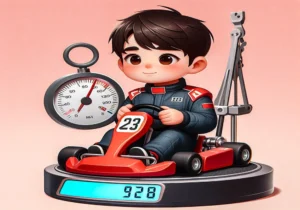Is There a Weight Limit for Go Karting?
Go-karting is an exhilarating activity enjoyed by many, but one common question arises: is there a weight limit for go-karting? This question often stems from concerns about safety, performance, and overall enjoyment of the sport.
In this guide, we will explore the weight limits associated with go-karting, why they exist, and how they impact the karting experience.
Weight Limits in Go-Karting

1. The Average Weight Limit for Go-Karts
Weight limits for go-karts are not universal and can vary depending on the type of kart and the facility. Most standard go-karts have an average weight limit between 160-170 pounds (72-77 kilograms).
However, this limit is flexible and can change based on the kart’s model, engine capacity, and the track’s safety guidelines.
Some karts are designed to support heavier drivers, and certain tracks may accommodate higher weight limits. It’s crucial to verify the specific weight limits of the go-karts at the venue before participating.
2. Considering Equipment Weight
When considering weight limits, it’s essential to account for the weight of safety equipment such as helmets and race suits.
These items contribute to the total weight the go-kart needs to handle. In competitive racing, additional weights might be added to the go-kart for balance or fairness, further impacting the total weight consideration.
Therefore, the combined weight of the driver and equipment determines if the kart falls within the safe operating limit.
3. Weight Limits for Adult and Professional Go-Karts
Adult go-karts typically have a weight limit between 250-300 pounds (113-136 kilograms). In professional karting, the restrictions are more stringent, with some championships setting the maximum weight limit at 190-200 pounds (86-90 kilograms).
Each track may have its own specific weight restrictions, so it’s essential to check with the local go-kart facility.
| Go-Kart Type | Average Weight Limit (Pounds) | Average Weight Limit (Kilograms) |
|---|---|---|
| Adult Go-Kart | 250-300 lbs | 113-136 kg |
| Child Go-Kart | 100-120 lbs | 45-54 kg |
| Professional Racing Kart | 190-200 lbs | 86-90 kg |
Why Does Weight Matter in Go-Karting?
1. Safety and Comfort Concerns
Weight limits are crucial for ensuring safety and comfort during go-karting. Exceeding the weight limit can affect the kart’s performance, making it harder to control.
For example, it could make steering around corners more challenging, slow down brake responses, and make sudden maneuvers more dangerous.
Overloading a kart also strains the engine, potentially leading to mechanical failures like a broken axle or a burnt-out engine.
A heavily loaded kart might navigate the track poorly, leading to an uncomfortable and potentially unsafe ride. Maintaining a weight within the specified limits ensures a safe and enjoyable experience.
2. Ensuring Fair Competition
In competitive go-karting, weight restrictions help ensure fair play. Lighter drivers often have an advantage due to better kart control and faster speeds.
A lighter kart can accelerate faster and handles better, especially around corners. To level the playing field, competitive events often enforce weight limits or introduce weight divisions.
This approach ensures all racers in a category have a similar total weight, emphasizing skill over physical attributes.
3. Weight Ballasting in Competitive Go-Karting
Weight ballasting involves adding weights to the kart of lighter drivers to match the heaviest driver in the race.
This practice ensures that all participants have an equal chance of winning, regardless of their individual weight.
Weight ballasting is commonly used in competitive go-karting to maintain fairness, although it is not typically used in casual go-karting.
The Impact of Excessive Weight on Go-Karting
1. Difficulty in Controlling the Go-Kart
Exceeding the weight threshold of a go-kart makes it harder to control. The kart’s responsiveness to steering inputs decreases, making it challenging to navigate tight corners or execute quick maneuvers.
The stopping distance increases with more weight, requiring more force to stop or slow down the kart. These factors increase the risk of accidents, especially at higher speeds or on challenging tracks.
2. Impact on Experience and Lap Time
The enjoyment of go-karting comes from the thrill of speed and the skill of driving. Excessive weight can dampen this thrill.
A heavier kart takes longer to accelerate, and the increased load on the engine reduces overall speed. This slowdown affects lap times and diminishes the excitement of the activity.
Maintaining an optimal weight can enhance the go-karting experience, keeping it fun and competitive.
| Weight Category | Weight Range (Pounds) | Weight Range (Kilograms) | Impact on Lap Time |
|---|---|---|---|
| Light | Less than 150 lbs | Less than 68 kg | Every 22 lbs (10 kg) of extra weight could make the driver approximately 0.2 seconds slower per lap. |
| Medium | 150-180 lbs | 68-82 kg | The expected lap time for a 160 lbs (73 kg) driver might be 31.2 seconds, while for a 180 lbs (82 kg) driver, it could be 31.6 seconds. |
| Heavy | More than 180 lbs | More than 82 kg | A driver who is 121 lbs (55 kg) heavier could be around 3.5 seconds slower over a 39-second lap. |
3. Risk of Overloading the Go-Kart
Overloading a go-kart puts excessive strain on its mechanical parts, such as the axles, engine, and brakes.
This strain can lead to premature failure of these components, potentially causing the kart to break down mid-race.
An unexpected malfunction, especially at high speeds, poses a significant risk of accidents and injuries. Therefore, staying within the weight limit is crucial for both safety and enjoyment.
FAQs
Are there specific types of go-karts designed for heavier drivers?
Yes, some go-kart models are designed to accommodate heavier drivers. These karts usually have a more robust build and a more powerful engine to handle additional weight. Availability varies based on the track or rental service, so it’s advisable to check in advance.
Does the weight of a child affect their ability to drive a go-kart?
Children’s go-karts are designed with a lower weight limit to suit their lighter weight and smaller size. If a child is significantly lighter than average, it may affect their ability to control the kart effectively. It’s best to discuss any concerns with the staff at the go-kart track, as they can provide guidance based on their specific karts.
Can I still participate in go-karting if I’m close to the weight limit?
Yes, you can still participate if you are close to the weight limit, but you might experience a slower ride compared to lighter drivers. If you are in a competitive race, weight classes or adjustments may be made to ensure fairness. Always check with the go-kart facility to understand their specific rules and policies.
Conclusion
Weight limits in go-karting are essential for ensuring safety, comfort, and fairness. These limits, which vary across tracks and kart models, help prevent mechanical failures and provide a balanced competitive environment. Exceeding these limits can compromise control, affect lap times, and risk kart malfunction. By understanding and adhering to weight limits, you can ensure a safe, enjoyable, and thrilling go-karting experience.

Jason Berry is a passionate enthusiast of all things go-karting. With years of experience in the industry, he has dedicated himself to exploring and uncovering the world of go-karts, from the adrenaline-pumping races to the intricacies of design and performance. Jason’s expertise extends beyond just the tracks; he delves into the mechanics, the technology, and the community that surrounds these thrilling machines. Through his articles and insights, Jason aims to share his knowledge and help fellow enthusiasts make informed decisions about their go-karting adventures. Whether you’re a seasoned racer or a newcomer to the sport, Jason’s expertise and passion are sure to rev up your excitement for the best go-karts on the market.

